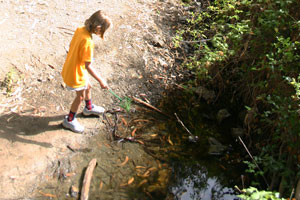 Raise your hand if you live in a watershed! Are all of your hands up? We all live in a watershed, an area of land that all water (from rain, snow and springs) flows across, under and through on its way into a common body of water, such as a creek, river, bay or ocean. The water may travel through city streets and into storm drains, over the surface of the ground and across farm fields, or suburban lawns, or it may seep into the soil and travel as groundwater. Along the way, water picks up and carries materials.
Raise your hand if you live in a watershed! Are all of your hands up? We all live in a watershed, an area of land that all water (from rain, snow and springs) flows across, under and through on its way into a common body of water, such as a creek, river, bay or ocean. The water may travel through city streets and into storm drains, over the surface of the ground and across farm fields, or suburban lawns, or it may seep into the soil and travel as groundwater. Along the way, water picks up and carries materials.
Everything we do impacts our watershed. Use of land and water from any part of the watershed, such as polluted run-off from farms, forests, ranches, and cities, eventually affects the health of the whole watershed – as well as the plants, animals and people within it.
A healthy watershed is important to everyone! Animals find food, water and shelter near creeks and waterways. Humans enjoy clean water and places to relax, swim and appreciate nature. One of the best ways to help your local watershed is to connect with it.
So, may I suggest a visit to that creek in your neighborhood for an old-fashioned, low-tech exploration? Bring binoculars, a nature journal, a creek creature identification sheet, and empty baby food jars. Bring some kids and all your senses.
At the creek, sit quietly and listen for the sound that is the nearest or the sound that is farthest away. Can you hear the creek running or the birds calling?
